.jpg.webp)
A bartizan (an alteration of bratticing), also called a guerite, garita, or échauguette, or spelled bartisan, is an overhanging, wall-mounted turret projecting from the walls of late medieval and early-modern fortifications from the early 14th century up to the 18th century.[1] Most frequently found at corners, they protected a warder and enabled him to see his surroundings. Bartizans generally are furnished with oillets or arrow slits.[2] The turret was usually supported by stepped masonry corbels and could be round, polygonal or square.[3][4]
Bartizans were incorporated into many notable examples of Scottish Baronial architecture. In the architecture of Aberdeen, the new Town House, built in 1868–74, incorporates bartizans in the West Tower.
Gallery
On walls
 Guarita at Fortaleza de Santiago, Sesimbra Municipality, Portugal
Guarita at Fortaleza de Santiago, Sesimbra Municipality, Portugal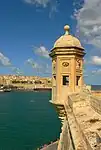
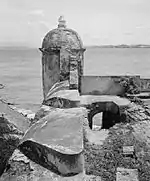
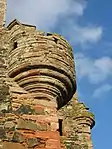 South-East Bartizan on Greenknowe Tower, Scottish Borders (and another one in the background)
South-East Bartizan on Greenknowe Tower, Scottish Borders (and another one in the background)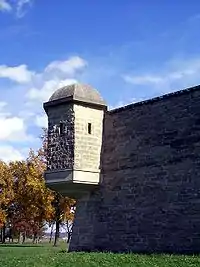
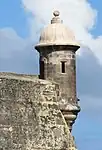 Garita at Castillo San Cristóbal (San Juan) in San Juan, Puerto Rico
Garita at Castillo San Cristóbal (San Juan) in San Juan, Puerto Rico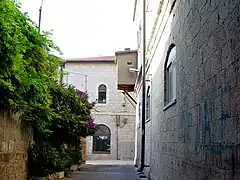
 Devil's Sentry Box, or the "Garita del Diablo", San Cristóbal Castle, in San Juan, Puerto Rico
Devil's Sentry Box, or the "Garita del Diablo", San Cristóbal Castle, in San Juan, Puerto Rico.jpg.webp) Bartizan of Fort del Fanal in Port-Vendres, Roussillon, France
Bartizan of Fort del Fanal in Port-Vendres, Roussillon, France
On towers


 Bartizans at Feartagar Castle, Ireland
Bartizans at Feartagar Castle, Ireland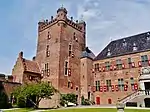 Courtyard of Bergh House, 's-Heerenberg, Netherlands
Courtyard of Bergh House, 's-Heerenberg, Netherlands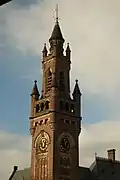 The Peace Palace bell tower, The Hague, Netherlands
The Peace Palace bell tower, The Hague, Netherlands_-_panoramio.jpg.webp) Martinstor, Freiburg, Germany
Martinstor, Freiburg, Germany
See also
- Bretèche
- Garret—an attic or top floor room in the military sense; a watchtower from the French word garite
- Hoarding (castle)
References
- ↑
 One or more of the preceding sentences incorporates text from a publication now in the public domain: Wood, James, ed. (1907). "Bartizan". The Nuttall Encyclopædia. London and New York: Frederick Warne.
One or more of the preceding sentences incorporates text from a publication now in the public domain: Wood, James, ed. (1907). "Bartizan". The Nuttall Encyclopædia. London and New York: Frederick Warne. - ↑ One or more of the preceding sentences incorporates text from a publication now in the public domain: Chisholm, Hugh, ed. (1911). "Bartizan". Encyclopædia Britannica. Vol. 3 (11th ed.). Cambridge University Press. p. 450.
- ↑ Bradley, Simon, ed. (2010). Pevsner's Architectural Glossary. Yale University Press. p. 219. ISBN 978-0-300-16721-4.
- ↑ Sturgis, Russell (1901). A Dictionary of Architecture and Building, Volume I. Macmillan. p. 219.